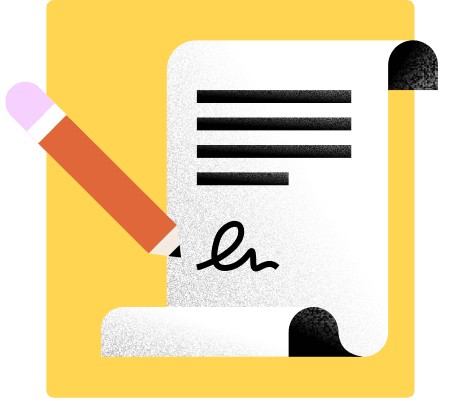Send cold emails like a pro with this guide to cold emailing for independent businesses. Discover cold emailing best practices and email templates—complete with sample subject lines—to help you kickstart the cold emailing process.

There are few things as intimidating as reaching out to someone you don’t know for the first time and introducing yourself. But as an independent business owner, that’s often the name of the game. Knowing how to send cold emails can be the difference between succeeding as an entrepreneur and falling on your face.
Using cold email templates can give you the confidence you need to reach out to business owners and individuals while growing your business. In this guide, we’ll walk you through cold emailing best practices and also offer some cold sales email templates you can use as a jumping-off point for sending your own cold emails.
Jump to:
- What is a cold email and when do you send one
- Best practices for cold emailing (so you don’t end up spamming)
- Cold emailing someone you were referred to
- Cold emailing a potential client with no connections
- Cold emailing press or public relations
- Cold emailing for link building
- Cold emailing a potential collaborator

So we’ve compiled an email template for every type of correspondence.

What is a cold email and when do you send one
Cold emailing specifically refers to emailing people you have no prior relationship with. These emails should be reserved for when you have one or more specific recipients you want to build a relationship with. Unlike sales emails, which are sent in bulk, the most effective cold emails are sent to specific prospects, or small subsets of prospective leads, for whom you can fulfill a specific need.
Cold emails have an average open rate of 18%. And 80% of customers prefer for sales representatives to email them rather than call them. But if you want your cold emails to be effective, you need to be strategic about when you’re sending them, who you’re sending them to, and how you’re crafting your emails. You also need to be strategic about your follow-up strategy—following up on your cold emails multiple times can double your response rate.
Cold emailing can feel risky. If you contact someone you have a prior relationship with, it’s more likely they’ll respond. But if you need to build connections in PR, want to build links on your website, or are reaching out to a referred client, cold emailing is often part of the game. The key is to have a strong strategy in place for sending cold emails that people want to respond to.
Best practices for cold emailing (so you don’t end up spamming)
Whenever you send a cold email, you’re walking a delicate line. If you send cold emails the right way, cold emailing can be a smart business practice that provides value for both you and the person you’re emailing. But if you send cold emails the wrong way, you can come across as spammy, which can negatively impact your business’s reputation. So before you start cold emailing, familiarize yourself with cold emailing best practices.
Focus on your subject line
Your subject line determines whether or not your email gets opened. It is, therefore, the most important part of your email. Subject lines should serve as a brief summary of what your email contains and why they should open it.
For example, a subject line that says, “Just wanted to check in…” provides zero value to the recipient.
In contrast, a subject line that says, “Are you looking for a freelance writer for your blog?” gets directly to the point and gives the recipient some context for what they’ll find in your email. From there, the recipient can decide whether your email is worth their attention. This transparent approach feels much less like spam.
Be intentional with your recipients
Sending cold emails doesn’t mean sending as many emails as possible. If you’re just sending out numerous cold emails and paying little attention to who the recipients are, your emails will probably get flagged as spam. You should be intentional with your recipients and email people who could actually benefit from working with you or directly work with businesses like yours—or who have a high likelihood of using your services.
Before you add a name to your email list, ask yourself how they would benefit from your business. If you owned a business like theirs, would you open or reply to your email? If the answer is no, they probably shouldn’t be on your email list.
In addition to being intentional with your recipients, you should also make a point of personalizing your emails. Have a system for ensuring the recipient’s name or business name is included in the email, and segment your email lists so that recipients are only receiving emails directly related to their business.
Some of the most successful cold emailers take personalization a step further and craft individual emails for each recipient. While this may not always be possible, you may find your cold email campaigns are more successful when you can make time to personalize them.
Introduce yourself
The whole idea of a cold email is that you’re emailing people who don’t know you. So one of the first things your email should do is introduce who you are, what your business is, and how you can provide value to the person you’re emailing. Consider including social proof in the form of reviews from other clients, and provide the address to your website or online portfolio if you have one.
But while it’s a good idea to send emails that include social proof, what you don’t want to do is send attached portfolios or work samples. Anyone who has taken an internet safety course will have heard not to open attachments from emailers they don’t know, and seeing attachments on cold emails can be a red flag.
Focus on their needs
Outreach emails are an email marketing tactic, so it’s easy to think about what you need from the interaction. But if you want your sales pitch to be effective, you need to consider how the recipient can benefit from your interaction. Address a pain point that they might be facing and then prove how working with you would provide a valuable solution to that pain point.
In addition to focusing on what they need from your email, you also want to be respectful of their time. Keep your email short, sweet, and to the point. You don’t want the recipients to invest a lot of time into reading your initial email. If they respond and show interest in what you have to say, you can provide more information in follow-up communications.
Create a professional email signature
Use our email signature generator so all of your communications are branded and professional.
Cold emailing someone you were referred to
The easiest cold emails happen between you and someone you were referred to. Referrals at least give you a foot in the door— a point of contact so that the person you’re contacting doesn’t feel like you’re a random person off the street.
Copy/paste template:
Subject line: [Referrer’s name] suggested we should work together…
Email template:
Dear [Recipient name],
My name is [Name], and I was referred to you by [Referrer’s name].
I run a [description of business], and our mission is to [elevator pitch about your business, (1–2 sentences max)]. I would love to set up a meeting sometime soon to speak with you about how [description of service you offer] might benefit [Name of their business or services].
If you’re interested in setting that meeting up, please respond to this email or give me a call at [phone number].
I’ll reach out again at the end of the week if I haven’t heard from you before then.
Thank you for your time,
[Name]
[Business name]
Cold emailing a potential client with no connections
Emailing a potential client with whom you have no connections can be one of the more difficult emails to send. In this case, your goal—in as few words as possible—is to prove to the prospective client that your business could benefit them. Take special care to address their pain points and put their needs above yours.
Copy/paste template:
Subject line: Are you looking for a skilled [description of your business] to help [Name of their business]?
Email template:
Dear [Name],
I found your business while I was [description of whatever made you notice their business]. I love [description of something you enjoy about their business]. However, I noticed that you don’t seem to have [your skillset] working with your team.
My name is [Name], and I work for [Name of business]. Our mission is to [1–2 sentence elevator pitch for your business]. I believe that with our proven track record of success, we could help you [specific pain point you can help them address].
Is that something you’d be interested in?
You can find out more information about our business at [Business website “About” page] and read reviews from previous clients at [Business website reviews page].
If you believe—like I do—that we could both benefit from working together, feel free to email me back or give me a call at [phone number]. I’ll reach out again at the end of the week if I haven’t heard from you before then.
Thank you for your time,
[Name]
[Business name]
Cold emailing press or public relations
The nice thing about emailing press or public relations is that one of their main jobs is to field emails from interested parties. The main goal with these emails is to ensure that your subject line doesn’t look like spam (so they actually open your emails rather than sending your emails directly to the trash bin) and then to present your request in a concise manner. Like with all cold emails, explain why working with you benefits their press office, not just why it would benefit your business.
Copy/paste template:
Subject line: [Description of event or information] – Interested in a Press Release?
Email template:
Dear [Journalist name],
My name is [Name], and I run [Name of company]. Something really exciting is happening with our company, and I thought you might like to feature the story in your publication.
We’re excited to announce that [description of what the press release is about]. I believe that your readers would be interested in this story because [reason your press release would be relevant to their audience].
Is that something you’d be interested in covering? If so, I’m happy to give you more details.
You can email me or reach out to me by phone at [phone number].
Because this is a time-sensitive event, I will reach out again if I haven’t heard from you in 3 business days. Thank you for your time; I look forward to speaking with you soon.
Sincerely,
[Name]
[Business]
Cold emailing for link building
Link building is a valuable marketing strategy. The good thing with sending cold emails for link building is that, if you do it right, the people you’re reaching out to are also looking to build links on their websites. Look for sites with about the same amount of traffic as your site—these are the ones most likely to enjoy mutual benefits when partnering with your company.
Copy/paste template:
Subject: See you on [date]!
Subject line: Would you like more backlinks for [Website name]? I think we could help each other.
Email template:
Dear [Name],
I noticed your website when I was [reason you noticed their company]. I believe that we could both benefit from backlinking to each other’s websites.
My name is [Name], and I work for [Company name]. We [1–2 sentence elevator pitch].
Because we have similar target audiences but aren’t direct competitors, I believe that we could both benefit from working together. If you reference some of my articles on your blog, and I reference some of yours on my blog, we could both benefit from the backlinks and grow our Google rankings together.
Is that something you’d be interested in?
You can learn more about my company by visiting [website]. If you think working together for link-building purposes is a good idea, you can email me back or call me at [phone number].
Thank you for your time,
[Name]
[Business name]
Cold emailing a potential collaborator
The right partnership can boost both collaborators to new heights. But collaborating also means being able to work together on larger-scale projects, which usually take many meetings to iron out. The goal of your cold email should simply be to start the conversation.
Copy/paste template:
Subject line: Would you like more backlinks for [Website name]? I think we could help each other.
Email template:
Dear [Name],
I noticed your website when I was [reason you noticed their company]. I believe that we could both benefit from backlinking to each other’s websites.
My name is [Name], and I work for [Company name]. We [1–2 sentence elevator pitch].
Because we have similar target audiences but aren’t direct competitors, I believe that we could both benefit from working together. If you reference some of my articles on your blog, and I reference some of yours on my blog, we could both benefit from the backlinks and grow our Google rankings together.
Is that something you’d be interested in?
You can learn more about my company by visiting [website]. If you think working together for link-building purposes is a good idea, you can email me back or call me at [phone number].
Thank you for your time,
[Name]
[Business name]
Improve your cold email game with HoneyBook
Once you’ve heard back from a potential client after sending a cold email, turn them into a project with the HoneyBook Chrome Extension. HoneyBook is a clientflow management platform that helps you manage all client communications, so once a prospect gets back and is interested you can put them in your pipeline immediately.
From there, keep track of the emails you’ve sent to prospective clients, avoid sending duplicate emails, and manage follow-up correspondence so your emails always feel personal and carefully curated. HoneyBook makes it easy because your client communications are all in one place.
Use HoneyBook to improve your client communication
View all your communication in one place and automate key touchpoints to save time!



